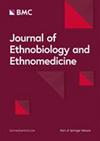美国的植物:亚历山大-冯-洪堡特关于北美本地实用物种的记录
IF 3.7
2区 医学
Q1 BIODIVERSITY CONSERVATION
引用次数: 0
摘要
1799 年至 1804 年间,德国博物学家亚历山大-冯-洪堡(Alexander von Humboldt)与艾梅-邦普兰(Aimé Bonpland)一起对美洲大陆进行了考察。在最终返回欧洲之前,他们决定在 1804 年 5 月 20 日至 7 月 7 日期间顺道前往美国。洪堡特在美国期间最详细的记录是一份题为 "Plantae des États-Unis"(1804 年)的手稿,其中包含该国有用植物和木材的信息。本文旨在首次检索洪堡手稿中有关北美植物及其用途的人种植物学信息,并强调历史文献和书目中对北美土著知识的抹杀和隐匿,主要是在 19 世纪。对 "Plantae des États-Unis"(数字化版本及其转录本)进行了仔细分析,并检索了手稿中提到的植物物种信息(包括植物学和方言名称、传统用途和一般观察结果)。传统用途与《美洲原住民民族植物学数据库》中的民族植物学数据、十九世纪和二十世纪初有关北美植物的百科全书式文献,以及在科学论文中搜索到的最新药理学研究相关联。手稿中提到的 28 种植物分布在 15 个植物科中,其中最具代表性的是椑科(9 种柞树)。除了一个未确定的物种(只提到了属,Corylus)外,所有物种都是美国本土物种。有 4 个物种被直接描述为药用植物(Toxicodendron radicans、Liriodendron tulipifera、Actaea racemosa 和 Gillenia stipulata),另外 4 个物种被描述为鞣剂(收敛剂)(Cornus florida、Diospyros virginiana、Quercus rubra 和 Quercus velutina)。两个物种被描述为苦味(Xanthorhiza simplicissima 和 A. racemosa)。报告中描述了九种栎树,但其中五种是欧洲最有用的栽培栎树(双色栎、蓖麻栎、弗吉尼亚栎、米乔栎和白栎);其中三种用于造船(弗吉尼亚栎、米乔栎和白栎),两种用于收敛(红栎和星栎),一种木材质量较差(黄栎)。一种被描述为黄色染料(Hydrastis canadensis),另一种被描述为有毒(Aesculus pavia)。有 10 个物种没有列出任何有用的用途。尽管《美国植物志》只是一本简短的注释集,但这些数据揭示了 19 世纪初美国具有社会和经济意义的优秀植物的历史情景。由于欧洲白人定居者和在美国出生的探险家不承认北美原住民的传统知识,这些数据凸显了在过去的历史记录和文献中压制原住民传统知识的明显过程。这份人种植物学清单可以帮助我们了解植物与北美原住民、欧洲博物学家和定居者以及过去在美国出生的人之间的关系,并思考原住民传统知识、生物经济、可持续管理和保护生物多样性在现在和未来的重要性。本文章由计算机程序翻译,如有差异,请以英文原文为准。
Plants of the USA: recordings on native North American useful species by Alexander von Humboldt
The German naturalist Alexander von Humboldt conducted an expedition through the American continent, alongside Aimé Bonpland, from 1799 to 1804. Before finally returning to Europe, they decided to take a side trip to the USA between May 20 and July 7, 1804. Humboldt’s most detailed account of his time in the USA consists of a manuscript entitled “Plantae des États-Unis” (1804), containing information on useful plants and timber of the country. The aim of this paper is to retrieve, for the first time, ethnobotanical information regarding North American plants and their uses inside this Humboldt’s manuscript as well as to highlight the erasure and invisibilization of North American Indigenous knowledge within historical documents and bibliography, mainly during the nineteenth century. “Plantae des États-Unis” (digitized version and its transcription) was carefully analyzed, and information on plant species mentioned in the manuscript (including botanical and vernacular names, traditional uses, and general observations) was retrieved. Traditional uses were correlated with ethnobotanical data from the Native American Ethnobotany Database and encyclopedic literature on North American plants from the nineteenth and early twentieth centuries, as well as recent pharmacological studies searched in scientific papers. In the manuscript are mentioned 28 species distributed in 15 botanical families, with Fagaceae (9 Quercus species) being the most representative. All species are USA natives, except for one undetermined species (only the genus was mentioned, Corylus). Four species were directly mentioned as medicinal (Toxicodendron radicans, Liriodendron tulipifera, Actaea racemosa, and Gillenia stipulata), while other four were described as tanning agents (astringent) (Cornus florida, Diospyros virginiana, Quercus rubra, and Quercus velutina). Two species were described as bitter (Xanthorhiza simplicissima and A. racemosa). Nine Quercus species were described, but five were reported as the most useful oaks for cultivation in Europe (Quercus bicolor, Quercus castanea, Quercus virginiana, Quercus michauxii, and Quercus alba); three of them were used for ship construction (Q. virginiana, Q. michauxii, and Q. alba), two as astringent (Q. rubra and Q. stellata), and one had wood of poor quality (Quercus phellos). One species was described as a yellow dye (Hydrastis canadensis), and the other was mentioned as toxic (Aesculus pavia). Ten species did not have any useful applications listed. Although “Plantae des États-Unis” is a brief collection of annotations, these data reveal a historical scenario of outstanding plants with social and economic interest in the USA at the beginning of the nineteenth century. The data highlight a clear process of suppression of the traditional knowledge of Native North American Indigenous peoples in past historical records and literature, due to the lack of acknowledgment by white European settlers and American-born explorers. This ethnobotanical inventory may help us understand the relationship between plants and Native North American Indigenous peoples, as well as European naturalists and settlers, and USA-born people in the past, and reflect on the importance of Indigenous traditional knowledge, bioeconomy, sustainable management, and conservation of biodiversity in the present and future.
求助全文
通过发布文献求助,成功后即可免费获取论文全文。
去求助
来源期刊

Journal of Ethnobiology and Ethnomedicine
PHARMACOLOGY & PHARMACY-
CiteScore
7.30
自引率
16.70%
发文量
66
审稿时长
>12 weeks
期刊介绍:
Journal of Ethnobiology and Ethnomedicine publishes original research focusing on cultural perceptions of nature and of human and animal health. Journal of Ethnobiology and Ethnomedicine invites research articles, reviews and commentaries concerning the investigations of the inextricable links between human societies and nature, food, and health. Specifically, the journal covers the following topics: ethnobotany, ethnomycology, ethnozoology, ethnoecology (including ethnopedology), ethnogastronomy, ethnomedicine, ethnoveterinary, as well as all related areas in environmental, nutritional, and medical anthropology.
Research focusing on the implications that the inclusion of humanistic, cultural, and social dimensions have in understanding the biological word is also welcome, as well as its potential projections in public health-centred, nutritional, and environmental policies.
 求助内容:
求助内容: 应助结果提醒方式:
应助结果提醒方式:


